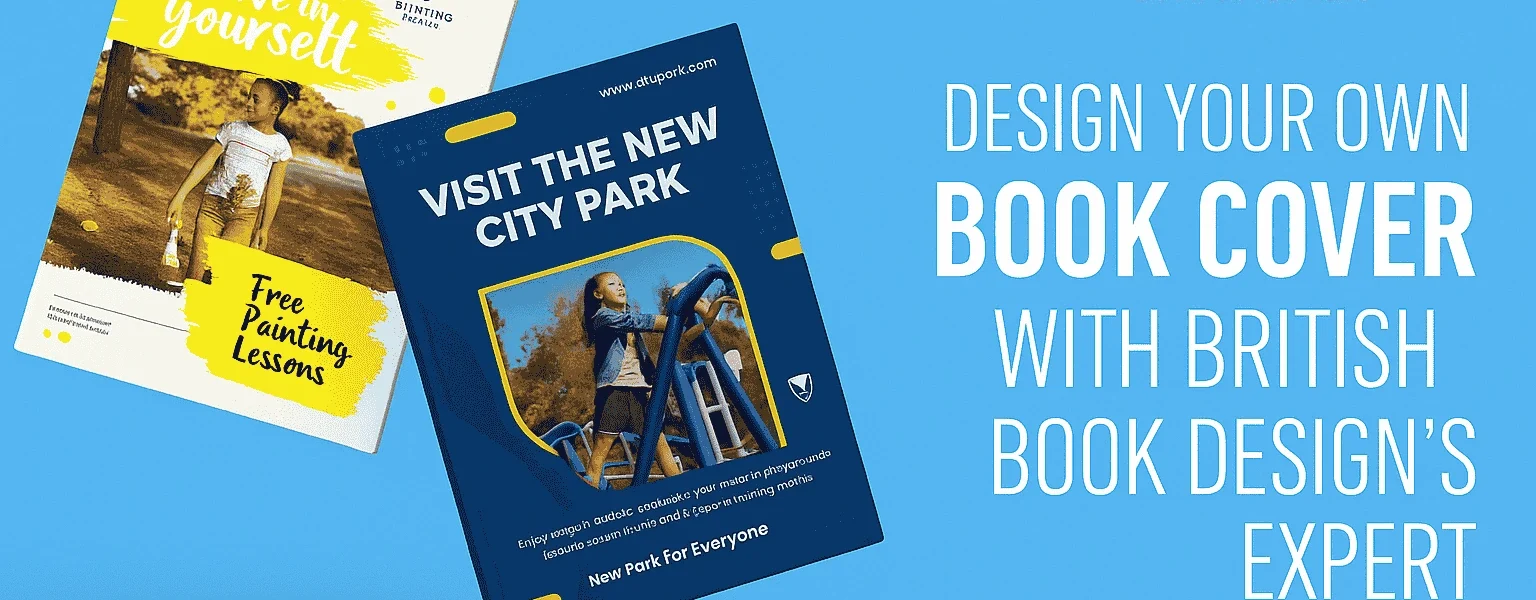Before you create your own book cover design, close your eyes and remember the last impactful case that caught your eye. Maybe it was the magical cover of Harry Potter with its unusual train, or the bold symbol of The Hunger Games? It could also have been the soft, classic look of Pride and Prejudice or the haunting simplicity of To Kill a Mockingbird‘s lone tree and shadowed bird.
These various types of cover are equally powerful and not just there to decorate the shelves. They have a purpose beyond looking nice, and it is to tell a part of the story before the reader opens the manuscript. Yes, it is what a great cover does: It sparks curiosity, emotions, and connection.
Let’s Design Your Next Book’s Cover in British Style
What is so special about the British-style book covers? Do they look fancier, or is it just about the vibe it gives? It seems like you should consult the ebook design services to understand the subtle difference between the dust jackets made by British book design experts and the others.
Let’s Begin with the Purpose of a Book Case
Regardless of whichever design style is being used, a book cover’s primary purpose is to attract the reader’s attention. The next most important aim is to communicate the book’s genre and tone to the audience, so that they get spellbound and pull out their wallets.
Moreover, the design must be so unique and deep that it keeps the reader in a hanging zone between: he knows the book is about and still doesn’t fully know it. Exactly this feeling of curiosity will push the audience to initiate purchases.
So, when you are confused about how to design a book cover, the answer is to create one with a purpose. It is important because aimless cover designs will only end up looking random, mislead the readers and fail in delivering the right message.
Now, Back to the ‘Exclusivity’ of British Hardbacks
The cases that were designed by experts from the UK have been seen featuring a minimalist aesthetic. Observations have also revealed that their focus is on negative space and sharp colour contrasts. American scripts, on the other hand, tend to be more visually elaborate and embellished.
Moving on, upon looking closely, it is evident that the British designs prioritise conveying the book’s essence through symbolic images. For example, the display of the manuscript The Hunger Games was created by one of the famous book cover illustrators, Tim O’Brien. His golden sparrow is a figure no one will ever forget. So, yes, it can be called a more minimalist approach.
However, the other designers do not necessarily do the same, as they aim for immediate visual impact. There are wide-ranging differences in what a British book design expert would create compared to the others. Some basic grounds can be the visual representation, colour palette, negative space, and historical context.
A Quick Table to Identify the Key Differences
In order to make your own book cover design, you must first be aware of the key fact that the front display is the initial thing a reader notices. And as it goes, first impression is the last impression, your cover should reflect the story’s heart, tone and personality quite transparently like a glass. Now, speaking of the British book cover designs, they usually stand out for their subtlety, sophistication, and storytelling style.
Especially when compared to covers from places like the United States, and other international markets such as France and Japan. Here’s a quick comparison to show how they differ depending on their cultural preferences.
| Feature | UK | US | Japan | France |
| Design Style | Minimalist, Abstract | Bold, Commercial, Genre-Driven | Clean, Delicate, Manga-inspired | Artistic, Poetic, Dreamlike |
| Colour Palette | Muted tones, A lot of white space | Bright, High-contrast colours | Soft pastels or monochrome | Earthy tones or rich hues |
| Typography | Elegant | Functional | Small and Neat | Handwritten |
| Image Focus | Illustrated or symbolic elements | Realistic photos, Character faces | Anime-style scenes or characters are illustrated | Conceptual art or paintings |
| Tone & Mood | Quiet, Cultured or Quirky | Direct, Dramatic | Gentle, Emotional and Reflective | Dreamlike, Philosophical or Abstract |
Each country’s creative book cover design reflects its reading culture. British covers often whisper; American ones shout. On the other hand, the Japanese covers feel like a soft breeze, while the French ones are more inclined towards visual poetry.
Let’s Find a British Book Design Expert & Get Him Onboard
To answer the question: how to design your own book cover, first, you must find a cover design expert and then work with them effectively for the finest results.
The journey is simple. You start by identifying your specific needs and budget. Then you utilise online platforms, professional organisations, and networking to find potential designers. Upon finding one, you must clearly communicate with him or her to ensure that the collaboration ends up successful.
1. Define Your Needs and Budget
The primary step to begin the search for a reliable hardback case designer is to first know your needs inside out. A great idea that works like magic is to have three pages in front of you and then answer the following questions to yourself, one by one.
Name the paper sheets: about the book, about the audience and about the budget. Then, as you pass a question, write down the answer on the relevant sheet. Once done, you will have quick notes about your direction and what exactly you need to look for in a designer.
- The first section will be related to your understanding of the book. Ask yourself:
- What is the core concept of my story?
- What genre(s) does it belong to?
- Is my story dark, lighthearted, or mysterious?
- What should be included on the cover to represent the story?
- What are some books in my genre that I like, and what specifically do I like about them?
- What makes my script unique and different from others in the same genre?
- The second section will be related to your practicalities and budget. Ask yourself:
- What is my budget range for this project?
- What is my timeline for the book launch?
- When do I need the cover design completed?
- Is there anyone who can design your own book cover free of cost, as a collaboration?
- What file formats and deliverables will I need from the designer?
- Do I have any specific preferences for the designer’s style or experience?
- Do I have any existing design elements that need to be used?
- The third section will be related to your understanding of the audience. Ask yourself:
- Who is my target audience, and what are their age, gender, and interests?
- What kind of cover design would charm my target audience?
- What are some popular and successful bookcases in my genre that were successful in interesting this group of the target market?
2. Utilise Online Platforms
Once you are aware of what your requirements for all three subjects are, you can move on to the second step of how to design your own cover page of a book. It says you need to start utilising the online platforms for finding the most reliable and talented designers.
Begin by asking your fellow authors, as they might connect you with someone experienced and trustworthy. You may also search for best-selling British novels and reach out to the illustrators that you think will understand your story. However, these two are not your only options; you can visit websites or freelance marketplaces like Upwork and Fiverr.
Open the sites and browse designer profiles by either viewing their portfolios or by reading client reviews. These are two strong factors that speak the truth. Then, if you are still unable to find an artist, you can hire dedicated agencies. Lastly, if nothing helps, you can join the online design communities like Behance. Here, they offer a wide range of design work.
3. Explore Professional Organisations
The next step is to connect with the Publishers Association. This is the organisation that will provide information about the publishing industry and may have resources for finding designers. Additionally, you may even become a part of the regional writing groups like New Writing North or the National Centre for Writing to find a book cover British expert designer. Another way is to look up the award-winning designers to hire the best of the best.
4. Evaluate Potential Designers
The fourth step is to review the portfolios and carefully examine the designer’s previous work. It will help you in assessing their style, technical skills, and suitability for your project. In addition to finding a perfect design artist, you need to check the client testimonials.
Simply start by reading the feedback from past clients and try to evaluate if the artist’s experience is beneficial to you. Apart from this, you may also talk to them and see how responsive, professional, and adaptable they are.

After that, if you think they are wise enough to be hired, you can start discussing with them the details of your story, the project’s deliverables, timeline, and payment structure.
5. Working with a Designer for Best Results
Last but not least, the final step is to get them onboard. This means you need to establish and maintain a two-way communication with your designer throughout the project. You must make sure that it is consistent and transparent. Then, as the channel establishes, you need to give the British designer clear and concise instructions.
If you want to design your own cover page of a book or website flawlessly, tell them everything, including your vision, target audience, and any specific requirements. On the side, stay prepared to offer constructive feedback on any design concepts and revisions that you feel are not working well for you.
However, overdoing it can be harmful to your script. Hence, trust the designer’s expertise, too, in creating a visually appealing and effective bookcase. In the end, carefully review all design elements before they are finalised to ensure they meet your expectations.
Significant Considerations While Designing These Hardcovers
A few technical aspects that should be on your mind when you are working with a British book cover design expert are listed below. You must go through them before starting this elaborate journey.
Genre and Market Alignment
Cover designers in the UK often customise them to the market expectations, which may differ from other global trends. Hence, be clear about your target audience so that the design fits the story perfectly.
Typography and Legibility
You need to ensure that the typography is the central design element. Moving on, the fonts need to be readable at thumbnail size if you want to place them in online stores. Besides this, the genre can also have a great impact on the font, changing it to serif for literary fiction and sans-serif for thrillers.
Print Specs and Trim Sizes
According to the reports, the British publishers may use different standard trim sizes than other industries. Thus, make certain that your book cover design is not bleeding or has the wrong spine width.
Color Profiles
For the print colours, you should use CMYK, which is the standard. However, for digital, do not go for anything but RGB. Additionally, make sure that your designer knows where the book will be printed or sold, so they can prep files accordingly.
Rights and Licensing
The final aspect that is clearly very significant is that the designs must not use any images that are not from the stock. Moreover, you cannot use fonts that are not properly licensed. In both cases, you can be subject to a punishable offence.
So, do consider this point while designing your own book cover with a British book design expert. Furthermore, you need to clarify who owns the final design and whether you can use it across different formats like eBook, audiobook, and merchandise.
The Final Words on Designing British-Style Manuscript Covers
British designers often take more creative risks and aim for a timeless, artistic feel. There are very few, or rather zero, instances of them focusing on instant impact and market trends. However, this approach doesn’t make them the winner.
It is just a different design philosophy shaped by audience expectations and publishing culture that you should know about if you want to design book of your next script. So, before you hire an expert from the UK, first get your facts straight and know exactly what you need by answering the questions mentioned above.

